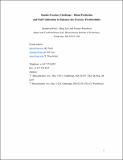Sandia Fracture Challenge: blind prediction and full calibration to enhance fracture predictability
Author(s)
Pack, Keun Hwan; Luo, Meng; Wierzbicki, Tomasz
Download10704_2013_9923_ReferencePDF.pdf (3.151Mb)
OPEN_ACCESS_POLICY
Open Access Policy
Creative Commons Attribution-Noncommercial-Share Alike
Terms of use
Metadata
Show full item recordAbstract
The Impact and Crashworthiness Lab at Massachusetts Institute of Technology participated in the Sandia Fracture Challenge and predicted the crack initiation and propagation path during a tensile test of a compact tension specimen with three holes (B, C, and D), using a very limited number of material properties, including uniaxial tensile tests of a dog-bone specimen. The maximum shear stress and modified Mohr–Coulomb fracture models were used. The predicted crack path of A–C–E coincided with two out of thirteen experiments performed by Sandia National Laboratories, and the maximum load, as well as the load level at the first and second crack initiation, was accurately captured. However, the crack-tip opening displacements (CODs) corresponding to the initiation of the two cracks were overestimated by 12 and 24 %, respectively. After the challenge ended, we received the leftover material from Sandia and did full plasticity and fracture calibration by conducting extra fracture tests, including tensile tests, on a specimen with two symmetric round notches, a specimen with a central hole, and a butterfly specimen with double curvature. In addition, pure shear tests were carried out on a butterfly specimen. Newly identified fracture parameters again predicted the A–C–E crack path, but the force–COD response could be reproduced almost perfectly. Detailed calibration procedures and validation are discussed. Furthermore, in order to investigate the influence of the machining quality on the results, a pre-damage value was introduced to the first layer of finite elements around the starter notch, A, and the three holes, B, C, and D. This accelerated shear localization between holes A and D (and between D and C as well) and changed the crack path to A–D–C–E. Parametric study on the pre-damage value showed that there exist two competing crack paths, and the corresponding force–COD curve is influenced by the pre-damage value. The effect of mesh size and boundary conditions are also discussed.
Date issued
2014-01Department
Massachusetts Institute of Technology. Department of Mechanical Engineering; Massachusetts Institute of Technology. Impact and Crashworthiness LaboratoryJournal
International Journal of Fracture
Publisher
Springer Netherlands
Citation
Pack, Keunhwan, Meng Luo, and Tomasz Wierzbicki. “Sandia Fracture Challenge: Blind Prediction and Full Calibration to Enhance Fracture Predictability.” International Journal of Fracture 186, no. 1–2 (January 10, 2014): pp. 155–175.
Version: Author's final manuscript
ISSN
0376-9429
1573-2673